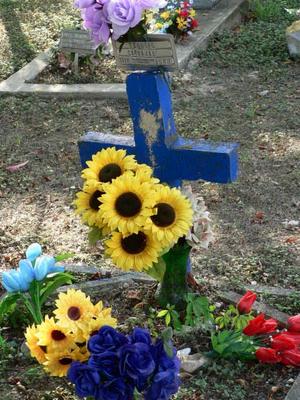I don't think the difference between the two is as much a view of death, as a view of life. Old "Anglo" cemeteries in Texas tend towards the grim and austere, though not so much as in New England. You won't find winged death's heads and "prepare for death, and follow me" verses on old Texas tombstones. Instead you will find sentimental doggerel or bible verses. But the overall look is still in the vicinity of the plain and unadorned. And there can be a certain loveliness to it.
Even though I began with a mention of the Mexican graveyard, I'll first show a picture of the Anglo cemetery, because I want to end this story with remarks about a grave in the Mexican camposanto.
Boggy Creek Graveyard.

There is a sad story at the beginning of the Boggy Creek graveyard, as with all graveyards, but this sad story survives: John Davis, in 1859, was part of a wagon train of occasional lumberjacks traveling to the pine forest in Bastrop, 30 miles away from Austin. They were camped along the way, and during the night John was sprayed by a skunk. When he ran shouting, possibly cursing, through the camp, he was mistaken for a Comanche raider and shot and killed.
His father, Jenkins Davis, who owned this land, brought his son back and buried him here. From our distance of a century and a half you could call it a funny story, for a moment at least, but I'm sure Jenkins loved his son as much as any of us love our own children.
Other settlers in the Manchaca community nearby were buried here. One of my Grandfather McCulloch's first cousins is here. By now it has about 1500 occupants. It's near my house. The reason I go birdwatching here is that it's quiet and little visited, and surrounded by a scrub cedar forest on 3 sides. It's owned by a Masonic lodge, which has far more members buried here than presently show up for meetings.
Cemetery shrike

To return to what should be at the beginning, in a properly written story, all we know of the origin of the Mexican graveyard is that a little girl, María de la Luz, daughter of some people traveling through, died and was buried here in 1912. (Most of the Mexican residents of Texas north of San Antonio were ethnically cleansed after the Texas Revolution in 1836. There were very few Mexican residents north or east of San Antonio until the Mexican Revolution in the early years of the 20th century, the turmoil of which led to a big wave of immigrants.) By the 1940s it had been become the graveyard for the small Mexican community in far south Austin. Like the Boggy Creek cemetery, it is now pretty much full, though both still have occasional burials.
The most shocking difference between the two cemeteries is color. Vibrant, saturated color. I'll let the pictures speak for themselves.
A blue cross

An old grave marker

Painted Jesus

A burial from the 1990s

A final note: I was reading that the Defense Department has begun targeting hispanics for recruitment, because recruitment for whites and African-Americans is falling. They plan to appeal to Mexican cultural norms of male honor and courage, on the one hand, and the desires of all immigrants to be more American than the Americans, on the other hand, to encourage them to join up. Actually, the recruiters have done this fairly successfully for many years. Here, freshly decorated, is the grave of Victor Flores, Lance Corporal, US Marine Corps, who died in Vietnam in 1965 at the age of 20. He would be 60 this year. Somebody tends to this grave, 40 years after his death.

No comments:
Post a Comment